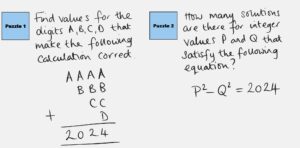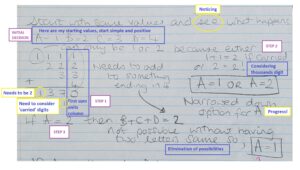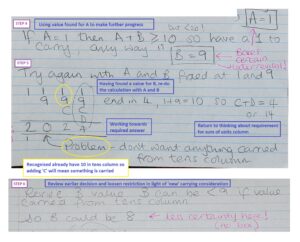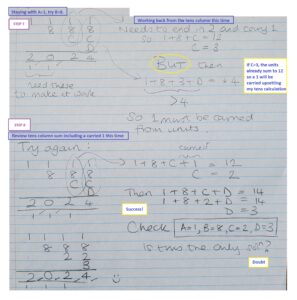Everyone loves a puzzle, don’t they?!
One of the pulls that drew me to maths is the satisfaction that comes from solving problems, that, and the fact it is fun!
In the May 2024 edition of the maths and stats (M&S) student newsletter, OpenInterval, there were two puzzles posed, sent in by one of our M&S associate lecturers, Bob Vertes:

Here’s my approach to Puzzle 1.
The use of different letters for the digits means 4 different digits, moreover single digits. This narrowed down my possibilities to the ten digits, 0 to 9. Reflecting now, there are still a large number of options – over 5000 ways (permutations) of selecting 4 different digits from 10:
![]()
More information definitely required to reduce the possibilities!
I figured I would just start simple and try some values to see what happened.

Notice my use of the word ‘figured’. Figuring in this sense means to think or consider but can also mean to calculate; perhaps my choice of language is influenced by the fact I am solving a maths problem. I also use the word ‘see’ – I am looking at the problem and noticing what happens when I try something; it is important to pay attention to what is happening to make some sort of structured progress, rather than just haphazardly working through a myriad combination of digits. This can be seen as an example of “Noticing Structure”, a module idea developed in our ‘Learning and Doing Algebra’ (ME322) module.
I began by summing the units column, just as taught when learning column addition. This led me to think about extra digits to consider, those that get ‘carried over’. For the thousands digit in the answer to be a 2, I would need a 1 carried over to combine with my existing 1. Alternatively, ‘A’ would need to be 2 and nothing carried over from the hundreds. ‘A’ could not be larger than 2, possibilities reduced by 80% in one move!
![]()
Note: automatic assumption I seem to have made without realising, ‘A’ cannot be 0.
I moved my attention to the units column; what would happen if ‘A’ was 2?
Look at the hundreds column. If ‘A’ is 2 then A + B + ‘anything carried’ would need to end in a zero but this would force a carry over into the thousands which is not wanted.
‘A’ cannot be 2.
Confirmation, ‘A’ should be 1.
Possibilities halved.
![]()
For the thousands digit in the answer to be 2, another 1 carried from the hundreds column is therefore needed. At this point I merrily proceeded to find that ‘B’ is 9, only for my confidence to be shaken at a later stage.

With my certainty shaken, I continue carefully.
If I can fix ‘B’, my remaining possibilities will be reduced significantly.
![]()

![]()
A final box confirms I am certain with my solution but spot the little doubt that has crept in with my question.
Mathematics is about confidence, but it is also about questioning and analysing and unpicking; all mathematical thinking.
As a maths teacher for many years, I am only too aware of and, always intrigued with, the many different methods pupils use to approach and solve problems. Whilst we can demonstrate particular ways to solve a problem, there is usually no single correct way. By looking at the approaches of others, we develop our own understanding of maths and its interconnectedness making links between our existing knowledge and knowledge, methods and ideas that may be new to us.
The next time you see a puzzle that needs solving, rather than rushing to get to the answer, take time to notice the steps you take along the way.
Now for Puzzle 2…
